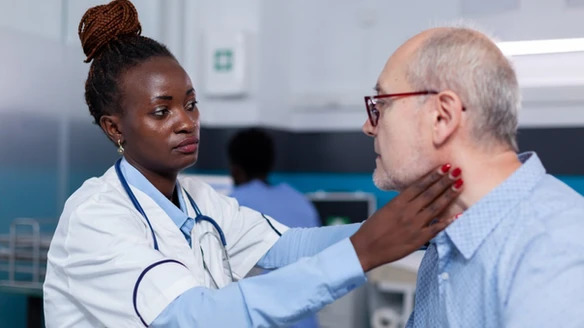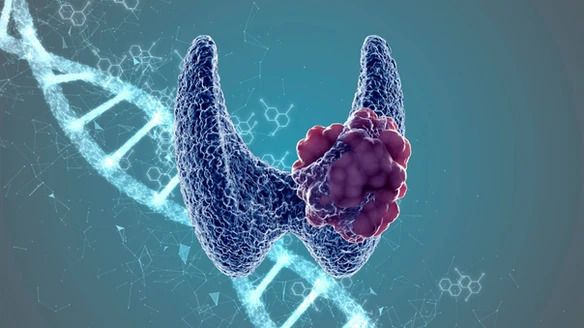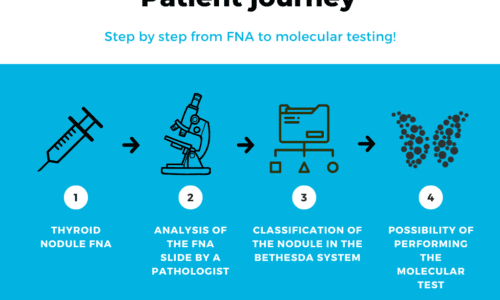- Marcos Santos, Ph.D
- 0 Comments
- 507 Views
Many patients receive their test results and panic when they read “thyroid nodule“. It is common for them to ask if it is cancer, if it is dangerous, what the treatment is like, and many other questions. But first of all it is important to remain calm.
The person who should interpret your test is the doctor, most likely an endocrinologist. You don’t need to suffer in advance. To guide you thru the process and to help you understand what the thyroid nodule may be, we have gathered some information and tips.
Thyroid Function
To understand the nodule, let’s go back a bit and understand the thyroid gland. It is a gland that has the shape of a butterfly and is located in the lower front part of the neck. The American Thyroid Association¹ states that the thyroid gland is responsible for producing hormones that help regulate metabolism. This gland can suffer from diseases that alter its shape or function.
Therefore, the most common thyroid diseases are those in which there is an alteration in the production of hormones, such as hyperthyroidism and hypothyroidism. However, changes can also occur in the structure of the gland, leading to the formation of thyroid nodules.
What is a Thyroid Nodule?
According to the Brazilian Society of Endocrinology and Metabolism², a thyroid nodule is a mass of thyroid tissue that has grown or a fluid-filled cyst that forms in the thyroid gland. There are different types of nodules, and they are like small “lumps” that can appear either individually or in multiples.
When a nodule appears, the greatest concern is the risk of it being malignant. However, in most cases, thyroid nodules are benign. It is known that only a small percentage of thyroid nodules are malignant (cancer)³. Nevertheless, it is essential to schedule an appointment with your doctor for an accurate diagnosis.
Symptoms of Thyroid Nodules
The majority of these nodules do not cause signs or symptoms¹. It is very common for them to be discovered during a routine physical examination or through imaging tests such as ultrasound or neck tomography. In some cases, the patient may feel the nodule while performing a self-examination by palpating the thyroid area. In some people, if the nodules become very large, they may experience:
- Swelling at the base of the neck;
- Pressure on the trachea or esophagus;
- Difficulty swallowing;
- Shortness of breath.
In some cases, the nodule can produce additional thyroxine (T4)³, a hormone secreted by the thyroid. This excess T4 in the body can cause symptoms of hyperthyroidism, such as:
- Unexplained weight loss;
- Increased sweating;
- Tremor;
- Rapid or irregular heartbeat.
What Causes Thyroid Nodules?
The chances of developing nodules increase as you age. By the age of 60, about half of people have a thyroid nodule¹. However, the cause of most benign nodules is unknown. It is known that iodine deficiency, genetics, and Hashimoto’s disease may be related to the formation of a nodule¹.
Diagnosis of Thyroid Nodules
Ultrasound is a fundamental examination for evaluating nodules. With it, it is possible to determine the size, contour, content, and number of nodules. However, to obtain more information about the nodule, the doctor may request a fine-needle aspiration biopsy (FNA). This is a very important tool in the analysis of thyroid nodules when there is a cancer suspicion.
According to the British Thyroid Foundation⁴, the FNA procedure involves the extraction of cells from the nodule using a very fine needle and causes minimal discomfort.
What can a thyroid nodule be?
Generally, the FNA report indicates if the nodule is:
Benign: This result is obtained in up to 80% of biopsies¹. It is represented in the report as “Bethesda II.”
Malignant: This is found in only about 5% of biopsies and represents thyroid cancer¹. It is represented in the report as “Bethesda V or VI.”
Indeterminate: This diagnosis can occur in up to 20% of cases¹. An indeterminate finding means that although an adequate number of cells were removed during the fine-needle biopsy, the microscopic examination cannot classify the result as benign or cancerous. It is represented in the report as “Bethesda III or IV.”
Therefore, when is surgery necessary?
Each case should be individually analyzed by the doctor. Generally, benign nodules do not need to be surgically removed unless they cause symptoms such as short breath or swallowing difficulties. However, periodic medical follow-up is necessary to monitor whether the nodule has grown or not.
In the case of malignant nodules, surgical removal is required after consultation with an endocrinologist and/or head and neck surgeon. Previously, the only option available to determine malignancy or benignity was to subject the patient to thyroid removal surgery. However, today there are new tests that perform molecular analysis and accurately classify the nodules. The mir-THYpe full molecular classifier is recommended for patients with indeterminate thyroid nodules (Bethesda III or IV).
Available throughout Brazil and Latin America, this test is a molecular test with solid scientific evidence⁵. It can be performed using the same slide from the previous fine-needle biopsy, avoiding discomfort and cost for the patient. If you suspect you have a thyroid nodule, consult your doctor. They can refer you to a specialist for diagnosis and treatment as needed. Get to know mir-THYpe it can provide valuable information about your nodule!
References:
- Thyroid Nodules, American Thyroid Association
- Entendendo a tireoide: nódulos, Sociedade Brasileira de Endocrinologia e Metabologia
- Thyroid nodules, Mayo Clinic
- Thyroid nodules and swellings
- Santos MT, Buzolin AL, Gama RR, et al. 2018. Thyroid 28(12): 1618-1626.







